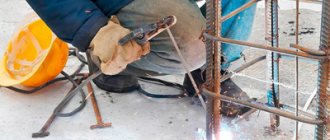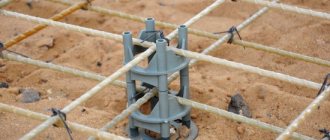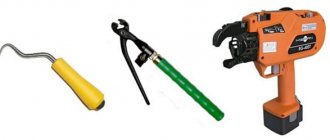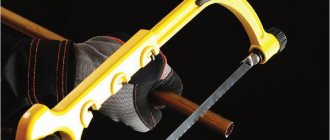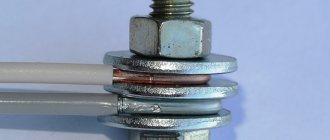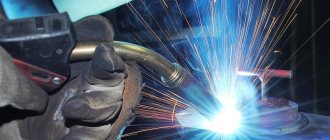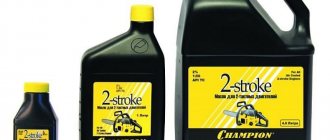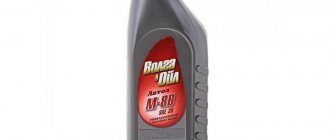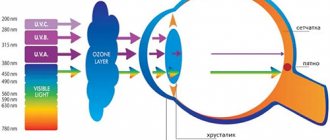Home |Reinforcement |Is it possible to weld reinforcement for the foundation?
Date: January 13, 2019
Comments: 4
When starting the construction of a house, we hope that it will be a reliable protection for the family hearth. In order for expectations to be met, you need to make an effort in your work, competently approach the solution of many issues, one of which is whether it is possible to weld reinforcement for the foundation.
There is still no consensus on what is better – welding or knitting a frame for the foundation. If for high-rise buildings, the foundation of which carries enormous loads, welded reinforcement is the only correct solution, then when constructing one-story buildings, expert opinions differ. Let's figure out what advantages and disadvantages are inherent in welding and knitting.
Strengthening the foundation - what is it for?
A well-designed and high-quality foundation is a guarantee of the durability of the structure. A strong, indestructible base will prevent shrinkage, which causes cracks and subsequent destruction of the structure. Therefore, strengthening the foundation is a serious issue that cannot be treated superficially. Increasing the strength of the foundation is achieved by reinforcing the structure with metal mesh or rods of a certain diameter.
Should the reinforcement for the foundation be welded or knitted - this is the main question that many people think about
For low-rise buildings, a strip foundation is most often installed. You can save money and fill the foundation with regular concrete without additional reinforcement. Most likely, after some time, cracks and deformations will appear in the foundation. To prevent undesirable consequences, carry out reinforcement work with a steel frame that:
- Increases strength.
- Evenly distributes the load.
- Compensates for soil reactions during freezing.
- Will increase the service life of the structure.
Reinforcement in concrete will protect the foundation from cracking and destruction.
The need to reinforce the load-bearing base
The durability of a residential building or other structure is guaranteed by a foundation built in accordance with all technical requirements using the correct technology for performing the work.
And if during the construction of such an important and main building structure as a load-bearing foundation, gross technological and technical errors were made, shrinkage deformations and cracks may appear on the load-bearing structures. The strength of the load-bearing base can be increased by reinforcing it with a metal spatial frame or reinforcing mesh.
Reinforcement products in solid concrete will reliably protect the monolithic foundation from the appearance of cracks and reliably protect it from possible destruction.
Methods for connecting reinforcing elements
There are various methods to increase the strength characteristics of the foundation. Private developers use any available material (waste metal, broken glass, etc.). For country houses this is an acceptable option. But to build a reliable house, even a one-story one, use proven technologies for strengthening with metal mesh or rods. If your choice is a mesh, then you only need to cut it correctly and install it properly in the prepared trenches. The use of metal elements implies the creation of a single structure from them, the so-called frame.
It is worth knitting reinforcement in cases where you need to get a good foundation on difficult soil
There are two ways to achieve this:
- tie using flexible wire for connection;
- apply welding to fix the structural elements.
Both options have strengths and weaknesses. Let's conduct a comparative analysis of each of them.
Influencing factors
You can generate a list of conditions influencing the choice of the type of connection of metal rods for foundations:
- Natural. According to the existing construction rules SNiP 52-01-2003, welded joints cannot be used on moving soils.
- Technical characteristics of the building. High-rise multi-storey buildings require high-speed construction, and for their construction it is recommended to use welded connections of reinforcing mesh and frames of foundation structures. Shallow foundations of private houses and small structures are best built on foundations using bonded metal products.
- Connection materials. Not every type of reinforcing bars can be welded using electric arc welding, which destroys the integrity of the bars and reduces their strength.
- Special equipment. Welding machines must be equipped with a regulator for smooth adjustment of the current strength.
- An appropriately qualified performer. High-quality welding can only be performed by an experienced welder. It is impossible to redo a poorly done job.
Reinforcement tying sequence
Reinforcement knitting technology
There are several ways to knit foundation reinforcement with special wire. This work is carried out directly on site. You can use the services of specialized workshops where the work will be completed efficiently and within the agreed time frame. There is a small downside to this service. You will have to find transport to transport large structures. In small settlements this is difficult and expensive. Therefore, we advise you to independently master the process of knitting frame elements:
- Decide on the number of connection points.
- Cut the appropriate number of pieces of steel wire 20 cm long. The diameter corresponds to 1.2-1.4 mm.
- Fold the cut piece in half.
- Bring the resulting loop to the junction of the elements.
- Use a crochet hook. You can make it yourself or purchase it in a store. Insert the working part into the loop.
- Grab the loose ends and pull them through the hole. The junction of the rods must be covered with wire.
- Tighten with maximum force and, by turning the hook several times, ensure a tight connection of the frame structure parts.
The reinforcement is knitted using a special wire that connects the rods at the corners of the structure
Knitting using a crochet hook is one of the cheapest, but most labor-intensive methods of connecting reinforcing elements. No expensive construction tools are used here; the work is carried out by one or two workers. If you want to speed up and make your work easier, you can purchase:
- automatic tying gun. With its help, the connection speed will increase significantly, but handling it requires certain skills;
- a rotary power tool, such as a drill or screwdriver with a special attachment, which can be purchased in specialized stores.
The advantages of automated devices include increased productivity, the ability to connect structural elements in hard-to-reach places of the frame, and a significant reduction in physical costs.
How to choose electrodes?
When carrying out welding work, the following types of electrodes are often used:
- UONI-13/55U. Suitable for welding with the formation of a pool of molten metal. The electrodes ensure high quality welds.
- ANO-21. Used with inverters for welding reinforcement directly over rust without stripping. Allows you to position the electrode at any angle to the surface to be welded.
- TMU-21U. Used for arc welding of critical structures. A special coating guarantees no spattering of molten metal, as well as stable arc burning. The slag is separated without problems.
- UONI-13/45. Used exclusively for reinforcing bars made of low-alloy or carbon steel. The seam has an optimal ratio of strength and ductility, so it does not burst or crack under load.
- OZS-12. The best choice if you want to create a weld with a uniform structure without pores, slag and oxidation.
Experienced welders of the 5th category can independently choose the optimal electrode for creating a weld, which will fully comply with the requirements for the operation of the structure. But most often the project contains instructions with requirements for the weld and the type of electrode used.
The diameter of the rods is selected as follows:
- For fittings with diameters of 5-8 mm, electrodes with a cross section of up to 3 mm are used.
- For rods with a diameter of 8-10 mm, it is recommended to use electrodes whose cross-section is 3-4 mm.
- For thick reinforcement with a diameter of 10 mm or more, electrodes with a diameter of 4 mm or more are used.
You can select according to labeling as follows:
- “N” – for metal surfacing;
- “U” – for alloys with low carbon content;
- “T” – for alloy steels with increased heat resistance;
- “E” – universal electrodes designed for creating plastic seams.
Organization of work
When starting work on creating a reinforced frame using the knitting method, purchase the necessary tools and materials in advance. By following simple recommendations, you will quickly master the connection technique and be able to perform the assigned tasks efficiently:
- Place the bottom row of horizontal structural elements at a short distance from the ground surface - 4/6 cm. Wooden or plastic pads are suitable to ensure the required gap. Their task is to prevent the frame from coming into contact with the soil.
- Install vertical elements at a fixed distance from each other.
Keep your step even. Ensure that the bars remain stationary using locking devices. Protect metal from contact with the ground using non-metallic cup holders. It is important to comply with this requirement to avoid corrosion of the reinforcement in the future. The knitting process itself is different in that it can be done either directly at the site of construction of the building or in a special workshop - Proceed to fixing the frame elements. Pay special attention to the reliability of connections. They must withstand the stage of pouring concrete mixture without moving.
- When constructing a reinforcing frame in several tiers, maintain equal distances between horizontal and vertical elements. Provide additional fastening to the corners of the structure - they tend to move during pouring. Make sure that the corner parts of the reinforcement are bent inward and do not protrude beyond the base.
- Observe the requirements laid down in the technical specifications for the selection of grades and assortments of materials.
- Carry out simple strength tests on the frame after completion of the work. Place a board on the top tier of the structure and walk along it - the frame should remain motionless under the influence of human weight.
- Immediately before pouring concrete, additionally fix the entire structure to prevent vertical deviations.
This will definitely interest you:
- Reinforcing frames: types of frames, production of reinforcing cages. Mounting rings
- Armopoyas (reinforced belt) Reinforced concrete beams over openings
- Monolithic strip foundation for a house made of gas silicate blocks Reinforcement of strip foundation
- Armopoyas Reinforced belt Do-it-yourself Armopoyas
- How to make a house roof with your own hands? How to build up rafters for an overhang?
- Site layout General plan of our site
- How to calculate how many blocks are needed for a house
- Modern roofing materials
- cesspool
- Mortar for laying blocks
Rebar welding technology
Although welding reinforcement for the foundation is more labor-intensive than knitting, it is impossible to completely abandon it. On large construction sites, when constructing multi-story buildings, it is impossible to do without welding. The foundations of such structures bear increased loads, and therefore the strength requirements are appropriate. To weld reinforcement for the foundation, use special brands of products - A400C or A500C. The diameter of the rods is within 3-5 centimeters. Resistance spot welding is used for the work. Considering the fact that when the metal overheats, changes in the structure occur, causing a weakening of the strength characteristics, it is desirable that the welding of reinforcement for the foundation takes place at specialized enterprises or is carried out on construction sites by qualified welders.
When welding, the strength of the reinforcement is reduced and the internal structure is damaged
The production of welded frames in industrial conditions is carried out in several stages:
- The technical control department checks the quality of materials that are planned to be used in the manufacture of the frame. Material that does not meet the requirements of standards and specifications is rejected;
- Round rolled steel made of St. 0 or St. 3, previously cleaned of rust and dirt, is straightened, marked, and cut to a given size. The elements are cleaned with an abrasive tool;
- the workpieces are connected into a flat structure. Spot welding of reinforcement is carried out with a workpiece diameter of up to 26 millimeters. When working with reinforcement of increased diameter, deformations of the structure occur due to strong heating during welding. To avoid distortion, the elements are lightly grabbed;
- Using special conductors, flat elements are installed vertically above each other at a calculated distance. Conductors are manufactured with a high degree of accuracy - deviations from the specified parameters do not exceed three millimeters;
- a preliminary bunch of elements is made;
- The compliance of the spatial design with the technical design is checked, the entire assembly as a whole is corrected, and the required length of welding seams is determined. To avoid deformation of elements from overheating, the sequence of welding joints is clearly defined;
- The spatial structure is finally welded.
Most often this method is used in places where the soil has a stable position, that is, it does not settle too much
When welding directly on a construction site, the procedure is similar. The only difference is the inconvenience of using arc welding. Therefore, when assembling a frame module on site, spot welding of reinforcement is used. It is mobile, and when equipped with special pliers, you can perform work even in a suspended state, with rotation to any angle.
Materials and equipment
Continuing to understand the question of whether it is necessary to weld reinforcement for the foundation, you need to pay attention to the devices and consumables used for this purpose.
It is recommended to use an inverter that performs resistance welding and operates on direct current. It is much more efficient than its transformer counterparts, which require variable current.
The semi-automatic unit works with special electrodes capable of cooking in an environment saturated with protective gases. The equipment has a special mechanism with protective properties that feeds electrodes automatically.
An inexpensive but outdated option is a welding transformer, which connects the fittings using electrodes that receive alternating current. This type of equipment works through a rectifier that converts alternating current into direct current. Like other equipment, resistance welding units are divided into two groups - professional devices and household ones.
The electrodes used for welding change the chemical composition of the connecting seam. Such elements are based on metal rods coated with a special composition that burns during welding.
This consumable material is marked as follows:
- “U” – resistance welding is allowed for products made of low-alloy metal;
- “L” – frames can be formed from alloyed metal;
- “T” – heat-resistant alloys are welded;
- “B” - such electrodes are recommended for joining high-alloy steel products;
- “N” – with their help additional layers are deposited.
In addition to the consumables discussed here, solid or flux-cored wire is used during welding, with the help of which weld deposits are formed.
Flux-cored wire has a special composition that facilitates the formation of a seam and increases its quality level. The diameter of such wire varies from 0.3 to 12 mm.
For a semi-automatic unit, it is recommended to use wire 0.3 – 1.6 mm.
Which connection method do you prefer?
Before you finally decide whether to knit or weld a reinforcement frame, weigh the pros and cons. Each connection method has positive and negative aspects. Recommendations from specialists will help you choose the optimal solution. When constructing multi-storey buildings with an increased load on the foundation, welding is clearly chosen. The diameter of the steel bar is selected to be at least 30 millimeters. Why should reinforcement with a larger cross-section be preferred? Answer: to minimize the risk of burnout, which will weaken the strength of the connection.
The disadvantages of the welding method, which limits the scope of application, include the occurrence of internal stresses, which increase the likelihood of cracking during casting. It is problematic to use in seismically unstable areas and on complex soils, where the shrinkage process takes a long time and can cause destruction.
But we must not forget about the advantages of welding:
Speed of work, allowing to significantly reduce construction time.
- Increased rigidity of the finished module.
- Obtaining a solid foundation that can withstand heavy loads.
For private buildings, it is better to use the knitting method, which:
- it is simple and accessible, even for those starting a construction career;
- eliminates the need to search for a welding machine and a high-class welder capable of performing work without defects;
- does not create additional stress at the joints;
- allows the use of cheaper reinforcement of reduced cross-section for reinforcement.
The disadvantages include slight rigidity, which is not particularly important when constructing low-rise buildings.
Boil or knit? That is the question…
Based on the above, we draw conclusions about: which methods are better to use in private construction - bonding or welding? Undoubtedly, each of the discussed methods is famous for its advantages, but there are also disadvantages. Welding proceeds at maximum speed, and knitting is a rather lengthy process, although it does not require a special apparatus. It is best used in the construction of private houses, cottages, outbuildings, and baths. It is in these cases that the method is most effective.
And when constructing buildings with large dimensions, attention turns to welding. Rods are used that have a diameter of more than . Therefore, connections using wire will present certain difficulties. Welding in this case will be the most correct solution.
However, the disadvantages of the welding method technology do not make it possible to use it on so-called difficult soils (and swampy areas practically exclude this method). After all, if a connection is used by welding, it will not withstand the external stresses that arise during shrinkage, which will lead to a loss of integrity of the structures and a loss of their rigidity. Tying technologies will ensure the most flexible connection of reinforcement on difficult soils. Here the rods, depending on the condition of the soil, will be able to move spatially without causing damage to the entire structure.
Video about methods of connecting reinforcement using various methods:
Normative references
This standard uses normative references to the following standards:
GOST 5264-80 Manual arc welding. Welded connections. Main types, structural elements and dimensions
GOST 6727-80 Cold-drawn low-carbon steel wire for reinforcement of reinforced concrete structures. Specifications
GOST 8713-79 Submerged arc welding. Welded connections. Main types, structural elements and dimensions
GOST 10922-2012* Reinforcement and embedded products, their welded, knitted and mechanical connections for reinforced concrete structures. General technical conditions
__________
* On the territory of the Russian Federation, GOST R 57997-2017 Welded reinforcement and embedded products, welded connections of reinforcement and embedded products of reinforced concrete structures is in force. General technical conditions.
GOST 14771-76 Arc welding in shielding gas. Welded connections. Main types, structural elements and dimensions
GOST 27772-88 Rolled products for building structures. General technical requirements
GOST 34028-2016 Reinforcing bars for reinforced concrete structures. Specifications
Note - When using this standard, it is advisable to check the validity of the reference standards in the public information system - on the official website of the Federal Agency for Technical Regulation and Metrology on the Internet or using the annual information index "National Standards", which was published as of January 1 of the current year, and on issues of the monthly information index “National Standards” for the current year. If the reference standard is replaced (changed), then when using this standard you should be guided by the replacing (changed) standard. If the reference standard is canceled without replacement, then the provision in which a reference is made to it is applied in the part that does not affect this reference.
Summary of what has been said
The answer to whether it is possible to weld reinforcement for a specific foundation is not always clear. A concrete monolith can withstand compressive loads well, but poorly in tensile loads. Reinforcement increases this figure by 10 times. Why are such different methods of creating frames used, such as knitting and welding? Because it is necessary to preserve the geometry of the steel frame until the final solidification of the monolith. The rod provides adhesion to concrete due to its periodic profile. The less it loses its properties, the better. This is why composite reinforcement is becoming so widespread. Its manufacturers increase not so much the strength of the fasteners as the adhesive properties. For these purposes, a layer of abrasive or sand is applied to the surface.
The development of mass accelerated construction has given rise to the widespread use of the welding method for the manufacture of steel frames. The availability of certified personnel, standard equipment, and certified materials made this method cheap and standardized.
The presence of steel embedded parts, rolled steel parts, and flat steel parts in the design makes it mandatory to perform separate welding joints.
Bottom line: you can weld reinforcement, except in those cases when you can’t. Choices are made during design and cost estimating.
Application area
This standard applies to welded connections of rod and wire reinforcement, welded connections of rod reinforcement with sheet and shaped rolled products, performed in the manufacture of reinforcement and embedded products of reinforced concrete structures, as well as during the installation of prefabricated and construction of monolithic reinforced concrete structures.
The standard establishes the types, design and dimensions of the specified joints made by resistance and arc welding.
The standard does not apply to welded connections of embedded products that do not have anchor bars made of reinforcing steel.
Significant reasons for choice
The choice will depend not only on objective factors that are based on the requirements of SNiP for the foundation. In most cases, opportunities, deadlines, and estimated budget play a significant role.
The performance of some operations with proper quality can only be ensured by the appropriate qualifications of the performer. It is necessary to carefully calculate, select, and prepare all consumables and tools. For welding this is one set, if you need to knit - another.
